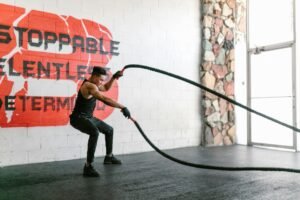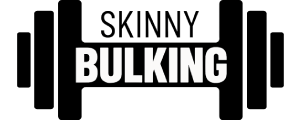As we age, our muscles naturally lose mass and strength. This can lead to a decrease in overall physical activity and an increased risk of injury. However, maintaining muscle mass and strength is essential for our overall health and well-being. It’s never too late to start building and maintaining muscle mass, and this guide aims to help you do just that. In this post, we’ll share 10 tips for building muscle over 40, including the importance of strength training, proper nutrition, and recovery. We’ll also discuss the benefits of resistance training for maintaining a healthy weight, increasing metabolism, and improving bone density. Whether you’re new to strength training or looking for new ways to improve your fitness routine, this comprehensive guide is a must-read for anyone interested in healthy aging.
1. Introduction: Why It’s Harder to Build Muscle Over 40

Image: pexels
As we age, our bodies undergo significant changes, and building muscle becomes harder. This is because our muscle mass naturally declines with age, and our body’s ability to synthesize protein decreases. In addition, our hormone levels, particularly testosterone, decrease, making it more difficult to gain muscle.
However, this does not mean that it is impossible to build muscle over 40. With the right approach and strategies, it is possible to gain muscle and maintain a fit and healthy body as you age. This guide will provide you with tips and insights on how to achieve this goal.
The benefits of building muscle over 40 are numerous. Not only does it help improve our physical appearance, but it also helps improve our overall health and well-being. It can help increase bone density and reduce the risk of osteoporosis, improve our metabolism, and reduce the risk of chronic diseases such as type 2 diabetes and heart disease.
So don’t be discouraged by the challenges that come with building muscle over 40. With the right mindset, dedication, and knowledge, you can achieve your fitness goals and maintain a healthy, active lifestyle well into your 40s, 50s, and beyond.
2. Start Slow and Gradually Increase Your Workload
It’s important to remember that building muscle over 40 is a process that requires patience and consistency. Starting slow and gradually increasing your workload is key to preventing injury and allowing your body to properly adapt to the demands of weight training.
Before jumping into a rigorous workout routine, it’s important to assess your current fitness level and determine what exercises and weight loads are appropriate for your body. This can be done by consulting with a fitness professional or a physician.
Once you have a plan in place, it’s important to start with lighter weights and fewer repetitions to allow your muscles to properly adapt to the demands of weight training. Gradually increasing your workload by adding more weight, sets, and reps each week will help you avoid injury and build muscle safely.
It’s also important to listen to your body and take rest days when needed. Overtraining can lead to injury and hinder progress. Remember, building muscle is a marathon, not a sprint. Slow and steady wins the race.
3. Lift Weights to Build Muscle
When it comes to building muscle, lifting weights is a crucial factor. As we age, our muscle mass naturally declines, and without proper exercise, this process can happen even more rapidly. However, lifting weights can help to counteract this process and actually help us to build muscle.
Resistance training has been shown to stimulate muscle growth and increase muscle protein synthesis. It also improves bone density, which is an important factor in maintaining overall health as we age. Plus, gaining muscle can help to increase metabolism, which can help with weight management.
When starting a weightlifting routine, it’s important to start slowly and gradually increase the weight and intensity over time. It’s also important to focus on proper form to prevent injury. Working with a personal trainer or fitness professional can be helpful in getting started and ensuring that you are using proper technique.
Incorporating a variety of exercises that target different muscle groups is also important for balanced muscle development. This can include exercises such as squats, deadlifts, bench presses, rows, and shoulder presses.
Remember, building muscle is a process that takes time and consistency. But with the right approach and dedication, it is possible to build muscle over 40 and enjoy the many benefits that come with a healthy, strong body.
4. Focus on Compound Exercises
When it comes to building muscle over 40, focusing on compound exercises is one of the most effective ways to achieve your goals. Compound exercises work multiple muscle groups at once, allowing you to target a larger area of muscle growth with one exercise.
Some of the most effective compound exercises include squats, deadlifts, bench presses, pull-ups, and rows. These exercises require more effort and energy than isolation exercises, but they will help you build more muscle mass in less time.
Compound exercises also stimulate the production of growth hormone and testosterone, which are crucial for muscle growth and recovery. As we age, our natural production of these hormones declines, making it even more important to focus on exercises that can help boost their production.
Incorporating compound exercises into your workout routine will also help you build functional strength, which is important for maintaining mobility and preventing injury as you age. So, if you want to build muscle over 40, make sure to prioritize compound exercises in your workouts.
5. Integrate Cardiovascular Exercise and HIIT

Image: pexels
Integrating cardiovascular exercise and HIIT (High-Intensity Interval Training) is an effective way to build muscle over 40. Cardiovascular exercise is essential for maintaining heart health and improving circulation, which is important for muscle growth and recovery. HIIT, on the other hand, is a form of exercise that involves short bursts of intense activity followed by short periods of rest. This type of training has been shown to boost metabolism, improve cardiovascular health, and increase muscle mass.
A combination of cardiovascular exercise and HIIT can help you burn fat while building muscle mass. This is because HIIT helps to increase your body’s natural production of growth hormone, which is essential for muscle growth. Additionally, incorporating cardio into your routine can help to increase your endurance and stamina, allowing you to push yourself harder during your weight training sessions.
When it comes to cardiovascular exercise, there are many options available. Running, cycling, swimming, and rowing are all great choices. Aim for at least 30 minutes of cardiovascular exercise three to four times per week.
For HIIT, there are many different workouts you can try. One popular option is Tabata training, which involves 20 seconds of intense activity followed by 10 seconds of rest, repeated for a total of four minutes. Other HIIT workouts may involve sprints, burpees, or jumping jacks.
Integrating both cardiovascular exercise and HIIT into your workout routine can help you build muscle over 40 and achieve your fitness goals. Just be sure to start slowly and gradually increase the intensity and duration of your workouts to avoid injury.
6. Prioritize Recovery and Rest
When it comes to building muscle over 40, recovery and rest are just as important as the workouts themselves. As we age, our bodies require more time to recover from intense exercise, making proper recovery techniques essential. Focusing on recovery and rest means giving your body the opportunity to repair itself and come back stronger for your next workout.
One of the simplest ways to prioritize recovery is by ensuring that you are getting enough sleep. Aim for 7-8 hours of quality sleep every night. This will allow your body to fully recharge and recover from the stresses of your day, including your workouts.
Another important aspect of recovery is nutrition. Make sure that you are consuming enough protein to support muscle growth and repair. Additionally, consuming carbohydrates after your workouts can help replenish glycogen stores, which are depleted during exercise.
Stretching and foam rolling are also excellent recovery techniques to incorporate into your routine. These can help alleviate muscle soreness and tightness, improve flexibility, and increase blood flow to the muscles.
Finally, it’s important to listen to your body. If you are feeling overly fatigued or experiencing pain, it may be a sign that you need to take a break or scale back on your workouts. Prioritizing recovery and rest will allow your body to perform at its best and help you achieve your muscle-building goals over 40.
7. Increase Protein Intake
As we age, our body tends to lose muscle mass, and this process can be accelerated if we don’t take care of our diet. One of the most important nutrients that our body needs to build and repair muscles is protein. Increasing your protein intake can help you to build muscle mass, preserve the muscle that you already have, and recover faster after exercise.
As a general rule, it is recommended that adults consume at least 0.8 grams of protein per kilogram of body weight. However, if you’re trying to build muscle, you’ll need to increase this amount. Depending on your fitness goals, you may need to consume between 1.2 to 2 grams of protein per kilogram of body weight.
You can increase your protein intake by consuming foods that are rich in protein such as eggs, chicken breast, turkey, beef, fish, dairy products, beans, lentils, and nuts. If you struggle to get enough protein through your diet, you can also consider using protein supplements such as whey protein, casein protein, or plant-based protein powders.
Remember that protein alone won’t build muscle. You need to combine a healthy diet with resistance training exercises to see the best results. Make sure to speak with a qualified fitness professional or a registered dietitian to find the right protein intake for your goals and needs.
8. Monitor Your Calorie Intake
Monitoring your calorie intake is crucial for building muscle over 40. As we age, our metabolism slows down, which means we burn fewer calories at rest. This makes it even more important to keep track of what we eat and how much we eat.
To build muscle, you need to consume more calories than you burn. This is known as a calorie surplus. However, it’s important to make sure you’re not consuming too many calories, as this can lead to excess fat gain.
To determine your calorie needs, you can use an online calculator or consult with a nutritionist. Once you have a rough estimate, you can adjust your calorie intake based on your progress.
In addition to monitoring your overall calorie intake, it’s important to make sure you’re getting enough protein. Protein is essential for muscle growth and repair, so aim to consume at least 1 gram of protein per pound of body weight per day.
It’s also important to focus on nutrient-dense foods, such as fruits, vegetables, whole grains, and lean proteins. These foods will provide your body with the vitamins and minerals it needs to function optimally and support muscle growth.
Remember, building muscle is not just about lifting weights. It’s also about making sure you’re fueling your body with the right nutrients and giving it time to rest and recover. By monitoring your calorie intake and focusing on nutrient-dense foods, you’ll be well on your way to building muscle over 40.
9. Track Your Progress

Image: pixabay
Tracking your progress is essential for building muscle over 40. It helps you understand the effectiveness of your workout routine and whether you are achieving your goals. There are many ways to track your progress, and the most popular methods include taking measurements, keeping a workout journal, and using wearable technology.
Taking measurements is an excellent way to track your muscle growth. You can measure your chest, arms, legs, and waist to see how much muscle you have gained over time. By comparing your measurements, you will see the areas where you have made progress and those that need improvement.
Keeping a workout journal is another effective way to track your progress. You can record the exercises you do, the sets and reps, and the weights you lift. This allows you to see your progress over time and make changes to your workout routine if necessary.
Wearable technology such as fitness trackers and smartwatches can also help you track your progress. These devices can monitor your heart rate, calories burned, and steps taken, among other things. Some devices even have built-in workout modes, which will track your exercises and give you feedback on your performance.
Tracking your progress is essential for building muscle over 40. It helps you stay motivated, monitor your progress, and make adjustments to your workout routine. By taking measurements, keeping a workout journal, or using wearable technology, you can easily track your progress and achieve your goals.
10. Conclusion: Building Muscle Over 40 is Possible and Beneficial
In conclusion, building muscle over 40 is not only possible but also highly beneficial for fit and healthy aging. As we age, we naturally lose muscle mass and strength, which can lead to a variety of health issues such as decreased mobility, increased risk of falls, and decreased overall quality of life. However, by incorporating regular strength training into your fitness routine, you can combat these effects of aging and improve your overall health and well-being.
It’s important to remember that building muscle over 40 requires a different approach than when you were in your 20s or 30s. Recovery time may take longer, and it’s important to listen to your body and not push yourself too hard. It’s also crucial to incorporate a healthy diet and lifestyle habits, such as getting enough sleep and staying hydrated, for optimal results.
By following the tips outlined in this guide, such as starting slowly, focusing on compound exercises, and incorporating variety into your routine, you can build muscle and improve your overall health and fitness at any age. So don’t let age be a barrier to achieving your fitness goals. With dedication and discipline, you can reap the benefits of building muscle over 40 and enjoy a fit and healthy lifestyle for years to come.







Leave a Reply